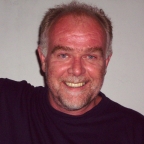 Born in 1960 in Greece, Dr. Harissopulos is the Head of the Tandem
Laboratory of the Institute of Nuclear Physics of the National Centre
for Scientific Research "Demokritos". He studied physics at
the University of Thessaloniki, Greece and received his PhD in June
1989 from the University of Cologne, Germany. For his PhD, he was
granted a scholarship from the German Academic Exchange Service (DAAD)
and carried out research in nuclear structure at the Institute of
Nuclear Physics (IKP) of the University of Cologne, focussing on
lifetime measurements with the plunger method. After his return to
Greece, he started as Assistant Professor at the
Technological-Educational Institute of Athens (Dept. of Physics and
Chemistry). In Dec. 1995, he was elected as a tenure-track research
scientist at "Demokritos". In Feb. 1999, he promoted to
senior researcher ("Principal Investigator") and in
Dec. 2006 to "Director of Research", a position equivalent
to that of a University Professor. In the period from June 2003 to May
2004, he was on sabbatical at the University of Bochum, Germany,
working with Prof. Claus Rolfs on the study of nuclear reactions
relevant to stellar nucleosynthesis and the detection of
geo-neutrinos. He has received a number of research grants either as
visiting scientist or scientist in charge. He has additionally been
convener of two workshops funded by the European Science Foundation
(ESF), the first one entitled "ESF Exploratory Workshop in
p-process nucleosynthesis" (2002) and the second one "ESF
Workshop on the future of stable beams in nuclear astrophysics"
(Dec. 2007).
Born in 1960 in Greece, Dr. Harissopulos is the Head of the Tandem
Laboratory of the Institute of Nuclear Physics of the National Centre
for Scientific Research "Demokritos". He studied physics at
the University of Thessaloniki, Greece and received his PhD in June
1989 from the University of Cologne, Germany. For his PhD, he was
granted a scholarship from the German Academic Exchange Service (DAAD)
and carried out research in nuclear structure at the Institute of
Nuclear Physics (IKP) of the University of Cologne, focussing on
lifetime measurements with the plunger method. After his return to
Greece, he started as Assistant Professor at the
Technological-Educational Institute of Athens (Dept. of Physics and
Chemistry). In Dec. 1995, he was elected as a tenure-track research
scientist at "Demokritos". In Feb. 1999, he promoted to
senior researcher ("Principal Investigator") and in
Dec. 2006 to "Director of Research", a position equivalent
to that of a University Professor. In the period from June 2003 to May
2004, he was on sabbatical at the University of Bochum, Germany,
working with Prof. Claus Rolfs on the study of nuclear reactions
relevant to stellar nucleosynthesis and the detection of
geo-neutrinos. He has received a number of research grants either as
visiting scientist or scientist in charge. He has additionally been
convener of two workshops funded by the European Science Foundation
(ESF), the first one entitled "ESF Exploratory Workshop in
p-process nucleosynthesis" (2002) and the second one "ESF
Workshop on the future of stable beams in nuclear astrophysics"
(Dec. 2007).
S. Harissopulos is currently a member of NuPECC (for Greece) and is representing the Greek funding agency (GSRT) in the FP7-ERA-Net in Nuclear Physics in Europe (NuPNET). He is a founding member of The Hellenic Nuclear Physics Society, elected Secretary from 1994 to 1996 and from 1999 to 2002, and elected President from May 2002 to May 2008. From 2003 to 2005, he served as (elected) member of the Governing Board of the Hellenic Researchers Association. He is member of the European Physical Society and the German Physical Society (DPG). His research activities include experimental nuclear astrophysics, nuclear structure, and applications of nuclear methods. He was chair and/or member of a number of International Conferences and Workshops, invited speaker and lecturer in many conferences and schools and referee in several scientific journals. He has served as an Independent External Evaluator of a number of PhD theses abroad. He has approx. 100 publications in referred journals and peer-reviewed conference proceedings with more than 400 citations. He is currently supervising 3 PhD students. [top] [personal webpage]
 Born in 1951, Dr. Fanourakis studied physics at the University of
Athens, Greece. He completed his post graduate studies in 1980 at NCSR
Demokritos and defended his PhD thesis at the University of Athens
(UoA) in the same year. He then moved to US and carried out research
at the University of Wisconsin, Madison (1980-1983 as research
associate), and the University of Rochester, (1983-1985 as research
associate, and from 1985-1993 as senior researcher). In 1993,
Dr. Fanourakis returned to Greece as a Visiting Associate Professor at
the University of Crete. In 1996, he was elected "Principal
Researcher" at INP and promoted to "Director of Research" in
2003. Dr. George Fanourakis has been doing research in the field
of Particle Physics since 1975, participating in experiments at Brookhaven National Laboratory (USA),
Fermi National Laboratory (USA) and CERN (Europe). He held leading
positions in the design, construction and operation as well as in data
analysis of several experiments and research projects such as: E613
(1978-1983) - charmed meson production, E706 (1983-1993) - direct
photon production, D0 (1987-1993) - Fermilab Collider experiment,
DELPHI (1996-2002) - LEP experiment, CMS (1997-2001) - LHC
experiment, ROSE (1997-2003) - radiation hard silicon detectors,
CAST (2001-present) - search for solar axions, Micromegas detector
development (2001-present) for X-ray detection and low background
physics. His scientific record includes more than 230 publications in
International refereed journals in Physics Research and many more
publications in Conference Proceedings and non-refereed editions. A
number of his publications involve development of MicroMegas
detectors.
Born in 1951, Dr. Fanourakis studied physics at the University of
Athens, Greece. He completed his post graduate studies in 1980 at NCSR
Demokritos and defended his PhD thesis at the University of Athens
(UoA) in the same year. He then moved to US and carried out research
at the University of Wisconsin, Madison (1980-1983 as research
associate), and the University of Rochester, (1983-1985 as research
associate, and from 1985-1993 as senior researcher). In 1993,
Dr. Fanourakis returned to Greece as a Visiting Associate Professor at
the University of Crete. In 1996, he was elected "Principal
Researcher" at INP and promoted to "Director of Research" in
2003. Dr. George Fanourakis has been doing research in the field
of Particle Physics since 1975, participating in experiments at Brookhaven National Laboratory (USA),
Fermi National Laboratory (USA) and CERN (Europe). He held leading
positions in the design, construction and operation as well as in data
analysis of several experiments and research projects such as: E613
(1978-1983) - charmed meson production, E706 (1983-1993) - direct
photon production, D0 (1987-1993) - Fermilab Collider experiment,
DELPHI (1996-2002) - LEP experiment, CMS (1997-2001) - LHC
experiment, ROSE (1997-2003) - radiation hard silicon detectors,
CAST (2001-present) - search for solar axions, Micromegas detector
development (2001-present) for X-ray detection and low background
physics. His scientific record includes more than 230 publications in
International refereed journals in Physics Research and many more
publications in Conference Proceedings and non-refereed editions. A
number of his publications involve development of MicroMegas
detectors.
Dr Fanourakis has been teaching at the undergraduate and graduate level since 1993 at the University of Crete, University of Athens, NCSR Demokritos and Greek National Technical University, and the Greek Open University. He has given seminars on scientific and technological subjects to High School teachers and summer students. He has also developed and given many public lectures in modern science at several places in Greece. Since 1997, the group headed by Dr. Fanourakis has been experimenting with novel science teaching methodology for High School students. Since 2003, Dr. Fanourakis is Chairman of the Scientific Advising Board of the INP, scientist in charge of the educational program of INP, and Chairman of the Outreach Committee of NCSR Demokritos. He is a member of the Greek Society of High Energy Physics. [top] [personal webpage]
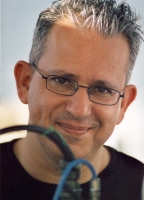 Dr. Karydas, born in 1962 in Greece, is senior researcher at the
Institute of Nuclear Physics of "Demokritos".He studied
Physics at the Physics Department of the University of Athens and he
received his PhD on Analytical Applications of Nuclear Techniques from
the Department of Physics of the National Technical University of
Athens. In 2002, Dr Karydas was elected by a scientific committee as
tenure-track researcher and on December 2006 was promoted to
"Principal Investigator", position equivalent to that of a
University Associate-Professor. His research activities include
development and application of Ion Beam and X-Ray Spectrometric
techniques in the interdisciplinary field (environmental science,
cultural heritage, and biomedicine). In particular, his current
research activities are focused on the study and implementation of 3D
μPIXE, development and characterization of an external ion-beam
end-station for the combined IBA of cultural heritage
artifacts/artworks, development of multipurpose PIXE-XRF technique,
development and application of portable milli- and micro- spot X-ray
Fluorescence spectrometers for cultural heritage, study of scattering
mechanisms between X-rays and atoms (X-ray Resonant Raman Scattering)
and study of the second order interactions that produce an enhancement
in the XRF intensity. He has published 51 articles in refereed
journals and 27 in special editions, books and conference proceedings
with more than 200 citations. He also performs regular referee tasks
for the peer review journals: X-Ray Spectrometry, Nuclear Instruments
and Methods B', Journal of Analytical Atomic Spectrometry and
Journal of Archaeological Science. Andreas Karydas has been
coordinator and/or scientist in charge in many projects funded by FP6
programmes or by national funding projects, mainly in the fields of
cultural heritage, conservation, and development of ion-beam
techniques. He has represented Greece as delegate in European actions
such as the COST-G1, "Ion beam study of art and archaeological
objects" and in COST-G8 "Non-destructive analysis and
testing of museum objects" actions as well as in the Regional
program RER/1/006 of the International Atomic Energy Agency (IAEA) entitled "Nuclear-Techniques for the Protection of
Cultural Heritage Artefacts"
[top] [personal webpage]
Dr. Karydas, born in 1962 in Greece, is senior researcher at the
Institute of Nuclear Physics of "Demokritos".He studied
Physics at the Physics Department of the University of Athens and he
received his PhD on Analytical Applications of Nuclear Techniques from
the Department of Physics of the National Technical University of
Athens. In 2002, Dr Karydas was elected by a scientific committee as
tenure-track researcher and on December 2006 was promoted to
"Principal Investigator", position equivalent to that of a
University Associate-Professor. His research activities include
development and application of Ion Beam and X-Ray Spectrometric
techniques in the interdisciplinary field (environmental science,
cultural heritage, and biomedicine). In particular, his current
research activities are focused on the study and implementation of 3D
μPIXE, development and characterization of an external ion-beam
end-station for the combined IBA of cultural heritage
artifacts/artworks, development of multipurpose PIXE-XRF technique,
development and application of portable milli- and micro- spot X-ray
Fluorescence spectrometers for cultural heritage, study of scattering
mechanisms between X-rays and atoms (X-ray Resonant Raman Scattering)
and study of the second order interactions that produce an enhancement
in the XRF intensity. He has published 51 articles in refereed
journals and 27 in special editions, books and conference proceedings
with more than 200 citations. He also performs regular referee tasks
for the peer review journals: X-Ray Spectrometry, Nuclear Instruments
and Methods B', Journal of Analytical Atomic Spectrometry and
Journal of Archaeological Science. Andreas Karydas has been
coordinator and/or scientist in charge in many projects funded by FP6
programmes or by national funding projects, mainly in the fields of
cultural heritage, conservation, and development of ion-beam
techniques. He has represented Greece as delegate in European actions
such as the COST-G1, "Ion beam study of art and archaeological
objects" and in COST-G8 "Non-destructive analysis and
testing of museum objects" actions as well as in the Regional
program RER/1/006 of the International Atomic Energy Agency (IAEA) entitled "Nuclear-Techniques for the Protection of
Cultural Heritage Artefacts"
[top] [personal webpage]
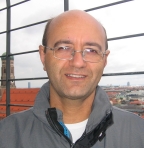 Born in 1961, Dr. Geralis is a Senior Researcher ("Principal
Investigator") at the Institute of Nuclear Physics at NCSR
Demokritos, Athens, Greece. He studied physics at the University of
Athens and graduated in 1983. He completed his post graduate studies
in 1985 at NCSR Demokritos and defended his PhD Thesis at the National
Technical University of Athens (NTUA) in 1991. His PhD concerned the
study of CP Violation in the K meson at the CPLEAR experiment at CERN,
where he contributed very significantly to the completion of the
Hardwired Trigger processor and the physics studies of the Neutral
Golden channels. He joined the Centre de Physique des Particules de Marseille (CPPM) group for the period 1988-1991
and the ETH Zurich group, as a post doctoral student, from 1991 to
1993 within the frame of the CPLEAR experiment. During the period 1993-1997 he played a leading role in physics analysis studies
(tau-polarization, Bhabha events, luminosity measurements) in the OPAL
experiment at LEP, as a Senior Research Associate at the Rutherford
Appleton Laboratory (RAL). He was also committed to operating the End
Cap Electromagnetic calorimeter of the OPAL experiment. His recent
work is devoted in the CMS experiment at LHC and the CAST (CERN Axion
Solar Telescope) experiment with the Institute of Nuclear Physics,
NCSR Demokritos. He is leading the team that designed and constructed
the Global Trigger Processor Emulator (GTPe) for CMS and the Data
Acquisition system for the micromegas CAST detectors and he is member
of the Institution's Board for the TriDas system in CMS. GTPe is a
system build that enables the CMS DAQ system stand alone installation,
multi-functioning implementation and upgrade. The Micromegas DAQ has
been used since 2003 for the CAST experiment data taking as well as in
DAQ systems for the Micromegas development.
Born in 1961, Dr. Geralis is a Senior Researcher ("Principal
Investigator") at the Institute of Nuclear Physics at NCSR
Demokritos, Athens, Greece. He studied physics at the University of
Athens and graduated in 1983. He completed his post graduate studies
in 1985 at NCSR Demokritos and defended his PhD Thesis at the National
Technical University of Athens (NTUA) in 1991. His PhD concerned the
study of CP Violation in the K meson at the CPLEAR experiment at CERN,
where he contributed very significantly to the completion of the
Hardwired Trigger processor and the physics studies of the Neutral
Golden channels. He joined the Centre de Physique des Particules de Marseille (CPPM) group for the period 1988-1991
and the ETH Zurich group, as a post doctoral student, from 1991 to
1993 within the frame of the CPLEAR experiment. During the period 1993-1997 he played a leading role in physics analysis studies
(tau-polarization, Bhabha events, luminosity measurements) in the OPAL
experiment at LEP, as a Senior Research Associate at the Rutherford
Appleton Laboratory (RAL). He was also committed to operating the End
Cap Electromagnetic calorimeter of the OPAL experiment. His recent
work is devoted in the CMS experiment at LHC and the CAST (CERN Axion
Solar Telescope) experiment with the Institute of Nuclear Physics,
NCSR Demokritos. He is leading the team that designed and constructed
the Global Trigger Processor Emulator (GTPe) for CMS and the Data
Acquisition system for the micromegas CAST detectors and he is member
of the Institution's Board for the TriDas system in CMS. GTPe is a
system build that enables the CMS DAQ system stand alone installation,
multi-functioning implementation and upgrade. The Micromegas DAQ has
been used since 2003 for the CAST experiment data taking as well as in
DAQ systems for the Micromegas development.
Dr. Geralis is actively involved in the design and development of the Micromegas detector for the CAST experiment and other applications. He is collaborating tightly with the CEA Saclay Micromegas group, which is leaded by I. Giomataris, the inventor of the Micromegas detector. He worked for well known Particle Physics institutes like the CPPM, ETH-Zurich, RAL, NTUA and NCSR Demokritos. He has published 218 papers in peer review High Energy Physics journals and has presented his work in numerous International Conferences. He has also been member of International Conferences Organizing committees. He has been elected three times in the Council of the Greek Society for High-Energy Physics. He is also actively involved in Education: teaching at post graduate and graduate level, supervising of PhD, Master and Diploma theses. [top] [personal webpage]
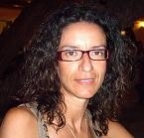 Dr Demetriou was born in Athens, Greece, in 1969. She studied physics
at the National University of Athens and graduated in 1991. In 1992
she was accepted as DPhil candidate at the University of Oxford and in
the same year, she was awarded a scholarship from the State
Scholarship Foundation after written examination. She obtained her
DPhil in Nuclear Reaction Theory at the University of Oxford in
February 1996. After her DPhil, she was accepted as a post-doctoral
fellow for 6 months at the Université Paris VI in Paris, in the
framework of a European Marie Curie Training Network. During that time
she worked with the group of Prof. R. Vinh Mau on the famous paris
Potential developing the short-range repulsive term from fundamental
aspects of the quark model. From 1996 to 1998 she held a post-doctoral
fellowship of the Istituto Nazionale di Fisica Nucleare of Italy, and
carried out research on electromagnetic interactions and the
constituent quark model at the Universitá degli Studi di Pavia,
Pavia, Italy, with the group of Prof. S. Boffi. From 1998 to 2002 she
held a Research Assistant Fellowship at the Institute of Nuclear
Physics of NCSR "Demokritos". During this period, she
initiated a long-lasting and fruitful collaboration with the INP
experimental Nuclear Astrophysics group on nuclear physics aspects of
stellar evolution and in particular, on nuclear reactions relevant to
the p process of nucleosynthesis. Moreover, she launched the theory
program on the development of global microscopic nuclear models for
large-scale reaction rate calculations of astrophysical
relevance. This program has been running for the past 10 years in
close collaboration with the Institut d'Astronomie et
d'Astrophysique (IAA), Université Libre de Bruxelles,
Brussels, Belgium. For the needs of this programme, she spent 3 months
as Visiting Scientist at the IAA in 2000. Parallel to these
activities, she has also had ongoing interests in the modelling of
nuclear reactions for applications in reactor technology, cancer
therapy and space aviation applications. During her term at the INP,
she got a grant from the General Secretariat for Research and
Technology, for a bilateral cooperation program with Poland from
2000-2002. The program was carried out in collaboration with the
A. Soltan Institute for Nuclear Studies, Warsaw, Poland and focussed
on the development of models for nuclear reactions at low and
intermediate energies that are relevant to various applications from
nuclear energy to medical physics. In 2002 she was awarded a European
Marie Curie Individual Fellowship to carry out research at the IAA,
Brussels for two years on the role of fission in the r-process of
nucleosynthesis. After the completion of her Marie Curie Fellowship,
she remained at the IAA for two more months as visiting Scientist. In
2005, she was a visiting scientist at the Institut de Physique
Nucleaire, Université catholique de Louvain, Louvain-la-Neuve,
Belgium for five months. She worked on nuclear reactions on silicon
targets at low and intermediate energies relevant to space aviation
applications, and in particular, to developing
radiation-hardened silicon components. After her term in
Louvain-la-Neuve in 2005, she was granted the European Re-integration
Grant of the Marie Curie Actions to return to "Demokritos"
and work on the development of global alpha-nucleus optical potentials
for p-process nucleosynthesis. In December 2006, she was elected
tenure-track research scientist. She has been a member of the
Organizing Committees of national and International Conferences as
well as of two ESF funded Workshops (ESF Exploratory Workshop in
p-process nucleosynthesis, 2002 and ESF Workshop on the future of
stable beams in nuclear astrophysics, 2007). She is the co-editor of
conference proceedings and has been an invited speaker at several
Universities and International Conferences and member of the Advisory
Committees of international Conferences. She has served as an
Independent Evaluator of Research proposals funding agencies abroad
and as a referee for Nuclear Physics A and Atomic Data and Nuclear
Data Tables. She has approximately 80 publications in peer-reviewed
journals and conference proceedings.
[top] [personal webpage]
Dr Demetriou was born in Athens, Greece, in 1969. She studied physics
at the National University of Athens and graduated in 1991. In 1992
she was accepted as DPhil candidate at the University of Oxford and in
the same year, she was awarded a scholarship from the State
Scholarship Foundation after written examination. She obtained her
DPhil in Nuclear Reaction Theory at the University of Oxford in
February 1996. After her DPhil, she was accepted as a post-doctoral
fellow for 6 months at the Université Paris VI in Paris, in the
framework of a European Marie Curie Training Network. During that time
she worked with the group of Prof. R. Vinh Mau on the famous paris
Potential developing the short-range repulsive term from fundamental
aspects of the quark model. From 1996 to 1998 she held a post-doctoral
fellowship of the Istituto Nazionale di Fisica Nucleare of Italy, and
carried out research on electromagnetic interactions and the
constituent quark model at the Universitá degli Studi di Pavia,
Pavia, Italy, with the group of Prof. S. Boffi. From 1998 to 2002 she
held a Research Assistant Fellowship at the Institute of Nuclear
Physics of NCSR "Demokritos". During this period, she
initiated a long-lasting and fruitful collaboration with the INP
experimental Nuclear Astrophysics group on nuclear physics aspects of
stellar evolution and in particular, on nuclear reactions relevant to
the p process of nucleosynthesis. Moreover, she launched the theory
program on the development of global microscopic nuclear models for
large-scale reaction rate calculations of astrophysical
relevance. This program has been running for the past 10 years in
close collaboration with the Institut d'Astronomie et
d'Astrophysique (IAA), Université Libre de Bruxelles,
Brussels, Belgium. For the needs of this programme, she spent 3 months
as Visiting Scientist at the IAA in 2000. Parallel to these
activities, she has also had ongoing interests in the modelling of
nuclear reactions for applications in reactor technology, cancer
therapy and space aviation applications. During her term at the INP,
she got a grant from the General Secretariat for Research and
Technology, for a bilateral cooperation program with Poland from
2000-2002. The program was carried out in collaboration with the
A. Soltan Institute for Nuclear Studies, Warsaw, Poland and focussed
on the development of models for nuclear reactions at low and
intermediate energies that are relevant to various applications from
nuclear energy to medical physics. In 2002 she was awarded a European
Marie Curie Individual Fellowship to carry out research at the IAA,
Brussels for two years on the role of fission in the r-process of
nucleosynthesis. After the completion of her Marie Curie Fellowship,
she remained at the IAA for two more months as visiting Scientist. In
2005, she was a visiting scientist at the Institut de Physique
Nucleaire, Université catholique de Louvain, Louvain-la-Neuve,
Belgium for five months. She worked on nuclear reactions on silicon
targets at low and intermediate energies relevant to space aviation
applications, and in particular, to developing
radiation-hardened silicon components. After her term in
Louvain-la-Neuve in 2005, she was granted the European Re-integration
Grant of the Marie Curie Actions to return to "Demokritos"
and work on the development of global alpha-nucleus optical potentials
for p-process nucleosynthesis. In December 2006, she was elected
tenure-track research scientist. She has been a member of the
Organizing Committees of national and International Conferences as
well as of two ESF funded Workshops (ESF Exploratory Workshop in
p-process nucleosynthesis, 2002 and ESF Workshop on the future of
stable beams in nuclear astrophysics, 2007). She is the co-editor of
conference proceedings and has been an invited speaker at several
Universities and International Conferences and member of the Advisory
Committees of international Conferences. She has served as an
Independent Evaluator of Research proposals funding agencies abroad
and as a referee for Nuclear Physics A and Atomic Data and Nuclear
Data Tables. She has approximately 80 publications in peer-reviewed
journals and conference proceedings.
[top] [personal webpage]
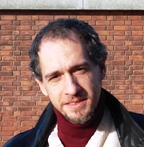 Born in 1973, Dr. Lagoyannis, studied physics at the University of
Ioannina, Greece and received his PhD in 2001. For his PhD thesis, he
carried out experimental work at GANIL, Caen, France, that focussed on
the structure of exotic light nuclei using proton scattering in
inverse kinematics with radioactive beams. At the same time he was a
visiting fellow at CEA-Saclay, Gif-sur-Yvette, France. After
completing his military service in 2003, he was appointed as Research
Assistant at the Institute of Nuclear Physics of
"Demokritos" and was responsible for the recent upgrade
works at the Tandem accelerator. He was a visiting scientist in a few
European laboratories in the last 2 years where he carried out
research in the fields of nuclear astrophysics and nuclear
structure. He is responsible for many collaborative programs related
to ion-beam-based nuclear analytical techniques. He has been a member
of the organizing committees of all recent workshops and international
conferences organized by INP. In the last 4 years, he has trained
almost the all students who carried out experimental work at the
Tandem laboratory for their Diploma in basic nuclear techniques and
instrumentation. In December 2007, he was elected tenure-track
research scientist. His record includes 40 peer-reviewed articles, and
15 papers in conference proceedings.
[top] [personal webpage]
Born in 1973, Dr. Lagoyannis, studied physics at the University of
Ioannina, Greece and received his PhD in 2001. For his PhD thesis, he
carried out experimental work at GANIL, Caen, France, that focussed on
the structure of exotic light nuclei using proton scattering in
inverse kinematics with radioactive beams. At the same time he was a
visiting fellow at CEA-Saclay, Gif-sur-Yvette, France. After
completing his military service in 2003, he was appointed as Research
Assistant at the Institute of Nuclear Physics of
"Demokritos" and was responsible for the recent upgrade
works at the Tandem accelerator. He was a visiting scientist in a few
European laboratories in the last 2 years where he carried out
research in the fields of nuclear astrophysics and nuclear
structure. He is responsible for many collaborative programs related
to ion-beam-based nuclear analytical techniques. He has been a member
of the organizing committees of all recent workshops and international
conferences organized by INP. In the last 4 years, he has trained
almost the all students who carried out experimental work at the
Tandem laboratory for their Diploma in basic nuclear techniques and
instrumentation. In December 2007, he was elected tenure-track
research scientist. His record includes 40 peer-reviewed articles, and
15 papers in conference proceedings.
[top] [personal webpage]
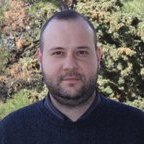 Born in 1977, Miltiadis Andrianis studied physics at the National
University of Athens (UoA) and received his Master's Degree in
the field of Electronics and Telecommunications from the
Physics-Informatics Department of UoA. His technical studies include a
wide range of subjects in the telecommunications field, such as
Analog- Digital Electronics, modulation transmission systems, and
wireless and wired voice and data networks. He was also engaged in
various projects ranging from pure engineering to business
analyses. His Master thesis was a project on an OFDM-based modem. He
was also involved in various projects including "The Viterbi
Algorithm", "Business opportunities through UMTS-WLAN
networks", "Risks & options in Capital
Investments", "A Mobile Network Dimensioning",
Estimation of 3G market services development”, “Parabolic
Reflectors" and "Wireless Networks". In his Diploma
thesis he designed and implemented a multiplier control unit in FPGA
Xilinx and performed a study on enabling technologies for optical
amplification for long-haul telecommunications. He has a five-year
professional experience as a Lecturer and lab instructor in technical
education at the professional development institute. He is responsible
for the Operation and Maintenance of the Tandem
accelerator.
[top] [personal webpage]
Born in 1977, Miltiadis Andrianis studied physics at the National
University of Athens (UoA) and received his Master's Degree in
the field of Electronics and Telecommunications from the
Physics-Informatics Department of UoA. His technical studies include a
wide range of subjects in the telecommunications field, such as
Analog- Digital Electronics, modulation transmission systems, and
wireless and wired voice and data networks. He was also engaged in
various projects ranging from pure engineering to business
analyses. His Master thesis was a project on an OFDM-based modem. He
was also involved in various projects including "The Viterbi
Algorithm", "Business opportunities through UMTS-WLAN
networks", "Risks & options in Capital
Investments", "A Mobile Network Dimensioning",
Estimation of 3G market services development”, “Parabolic
Reflectors" and "Wireless Networks". In his Diploma
thesis he designed and implemented a multiplier control unit in FPGA
Xilinx and performed a study on enabling technologies for optical
amplification for long-haul telecommunications. He has a five-year
professional experience as a Lecturer and lab instructor in technical
education at the professional development institute. He is responsible
for the Operation and Maintenance of the Tandem
accelerator.
[top] [personal webpage]
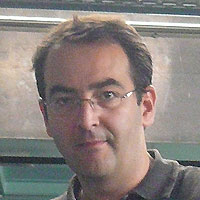 Theo Mertzimekis was born in 1971 in Serres, Greece. He completed his
undergraduates studies in Physics at the University of Ioannina in
1993. He took the first steps in research during his graduation
project, which involved studies in the area of radiochemistry and
environmental nuclear chemistry. He joined the Graduate Program in the
University of Ioannina since after his graduation. After completing
the required course work he decided to move to the USA and shift his
research interests towards fundamental nuclear studies. In 1997, he
joined Prof. Noemie Benczer-Koller's group at Rutgers, NJ, under a
full-time scholarship of the Department of Physics and Astronomy,
focusing on experimental studies of nuclear structure. He obtained his
M.S. in Physics in 1999 and gained large experience in measurements of
magnetic moments while running a large number of experiments at the
Tandem of WNSL, Yale University and the 88" Cyclotron at Berkeley. He
defended his Ph.D. Thesis in April 2002 and immediately moved to NSCL,
Michigan State University as a Research Associate in Prof. Paul
Mantica's group.He stayed at NSCL until 2006 with a one-year break due
to his compulsory military service pending back in Greece (2004). His
research at NSCL was funded by two NSF Grants and focused on
measurements of magnetic moments and beta-decay studies employing
radioactive beams. He has served as the spokeperson in two major
experiments at NSCL exploring the fundamental properties of
neutron-deficient isotopes near the proton-drip line. He also had the
opportunity to participate in experiments at the Australian National
University and TRIUMF. In 2006, he moved back to the University of
Ioannina, accepting a Visiting Assistant Position in the Physics
Department till 2008. His concurrent research work dealt mainly with
measurements of nuclear cross sections in stable Li isotopes near the
Coulomb barrier, receiving funds from the Greek GSRT (Pythagoras
I). He has recently moved to the Institute of Nuclear Physics in NSCR
"Demokritos", joining LIBRA, as a Research Associate.
Theo Mertzimekis was born in 1971 in Serres, Greece. He completed his
undergraduates studies in Physics at the University of Ioannina in
1993. He took the first steps in research during his graduation
project, which involved studies in the area of radiochemistry and
environmental nuclear chemistry. He joined the Graduate Program in the
University of Ioannina since after his graduation. After completing
the required course work he decided to move to the USA and shift his
research interests towards fundamental nuclear studies. In 1997, he
joined Prof. Noemie Benczer-Koller's group at Rutgers, NJ, under a
full-time scholarship of the Department of Physics and Astronomy,
focusing on experimental studies of nuclear structure. He obtained his
M.S. in Physics in 1999 and gained large experience in measurements of
magnetic moments while running a large number of experiments at the
Tandem of WNSL, Yale University and the 88" Cyclotron at Berkeley. He
defended his Ph.D. Thesis in April 2002 and immediately moved to NSCL,
Michigan State University as a Research Associate in Prof. Paul
Mantica's group.He stayed at NSCL until 2006 with a one-year break due
to his compulsory military service pending back in Greece (2004). His
research at NSCL was funded by two NSF Grants and focused on
measurements of magnetic moments and beta-decay studies employing
radioactive beams. He has served as the spokeperson in two major
experiments at NSCL exploring the fundamental properties of
neutron-deficient isotopes near the proton-drip line. He also had the
opportunity to participate in experiments at the Australian National
University and TRIUMF. In 2006, he moved back to the University of
Ioannina, accepting a Visiting Assistant Position in the Physics
Department till 2008. His concurrent research work dealt mainly with
measurements of nuclear cross sections in stable Li isotopes near the
Coulomb barrier, receiving funds from the Greek GSRT (Pythagoras
I). He has recently moved to the Institute of Nuclear Physics in NSCR
"Demokritos", joining LIBRA, as a Research Associate.
Theo has significant experience in nuclear structure studies. He has worked extensively with a large number of experimental techniques (TF technique, beta NMR, HVTF, re-cyclotron etc) in measurements of several nuclear observables such as electromagnetic moments and lifetimes, carrying out experiments with small and large detection arrays (Gammasphere, YRAST Ball, SeGA etc). He has recently accepted an invitation to join the international collaboration gPRESPEC, with main research activities at GSI. He has also run several experiments at GANIL, France, collaborating with scientists from the University of Sofia, Bulgaria, KU Leuven, Belgium and elsewhere, studying the structure of mid-weight exotic isotopes. His published record consists of 34 peer-reviewed publications, 8 papers in peer-reviewed conference proceedings and 8 in non-peered conference volumes. He has received more than 300 citations for his published work and excellent evaluations for his teaching. He has delivered 8 seminars after invitation, including an honored talk at the Gordon Conference of Nuclear Chemistry in 2001. [top] [personal webpage]
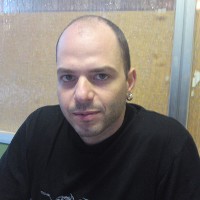 Axiotis Michael was born in 1976 in Athens, Greece. He studied physics
at the University of Cyprus and received his PhD in 2007 from the
Physics Department of the National Technological University of Athens.
His PhD thesis was in nuclear structure of nuclei with mass A=50. More
precisely he analyzed the high spins of 52Mn with gamma-ray spectroscopy
and also using Total Absorption Spectroscopy techniques he studied the
beta-decay of 52Fe. In parallel, from 1999 to 2003, he had a fellowship
at the Laboratori Nazionali di Legnaro in Italy. There, he was member of
the nuclear structure group and helped in the preparation and the
running of almost all the experiments done with the GASP
spectrometer. He also participated in experiments of the group at
other laboratories like IReS, GSI and Cologne and in
the building of the Clara spectrometer. Finally for a period of time between
2005 and 2006 he collaborated with Dr Demetriou on the development of
global alpha-nucleus optical potentials for p-process nucleosynthesis.
[top] [personal webpage]
Axiotis Michael was born in 1976 in Athens, Greece. He studied physics
at the University of Cyprus and received his PhD in 2007 from the
Physics Department of the National Technological University of Athens.
His PhD thesis was in nuclear structure of nuclei with mass A=50. More
precisely he analyzed the high spins of 52Mn with gamma-ray spectroscopy
and also using Total Absorption Spectroscopy techniques he studied the
beta-decay of 52Fe. In parallel, from 1999 to 2003, he had a fellowship
at the Laboratori Nazionali di Legnaro in Italy. There, he was member of
the nuclear structure group and helped in the preparation and the
running of almost all the experiments done with the GASP
spectrometer. He also participated in experiments of the group at
other laboratories like IReS, GSI and Cologne and in
the building of the Clara spectrometer. Finally for a period of time between
2005 and 2006 he collaborated with Dr Demetriou on the development of
global alpha-nucleus optical potentials for p-process nucleosynthesis.
[top] [personal webpage]
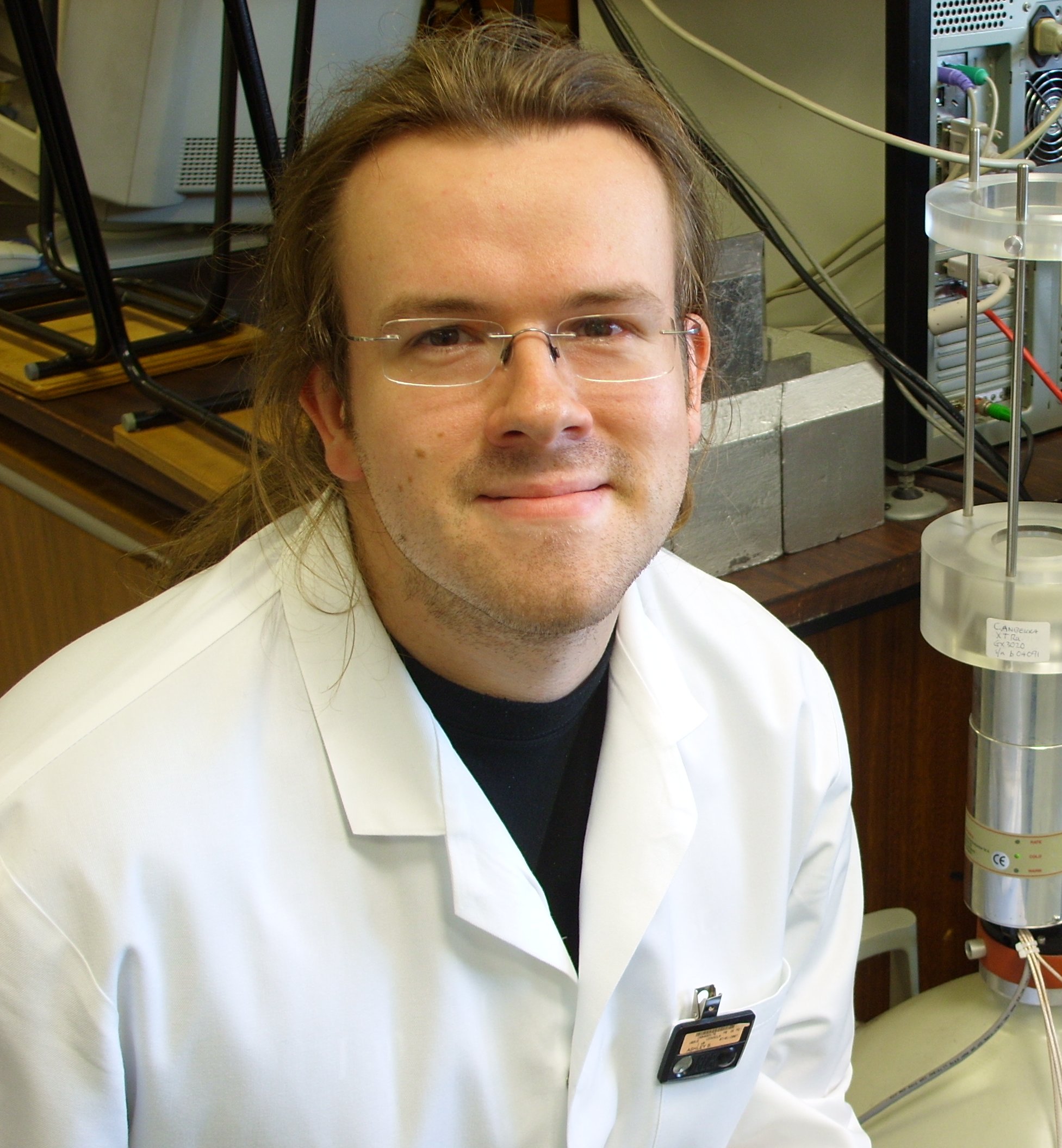 Stephen F. Ashley, born in 1982 in Cambridge, United Kingdom, is a
newly appointed LIBRA post-doctoral research scholar at NCSR
Demokritos. Stephen completed his undergraduate studies at
Staffordshire University and obtained a B.Sc. (Hons) in Physics in
2003. He then undertook his Ph.D. studies in nuclear structure
physics, under the supervision of Professor Paddy Regan, at the
University of Surrey. His Ph.D. work centred round determining the
lifetimes of excited nuclear states within the nanosecond to
picosecond range. In particular, this research centred on
fusion-evaporation reactions to populate excited states in
cadmium-106, culminating in two experiments at the Wright Nuclear
Structure Laboratory, Yale University and the Institut für
Kernphysik, Universität zu Köln, and in July 2007, he successfully
defended his Ph.D. thesis. In March 2008, he was employed as a
post-doctoral research scholar in the Department of Chemistry at the
University of Kentucky, Lexington KY, USA. During his time there, he
assisted with experiments that utilised inelastic neutron scattering
to probe the low-lying, low-spin excited states in atomic nuclei. He
also helped with the characterisation of prototype BC530 liquid
scintillation detectors for the proposed DESCANT array at TRIUMF
Vancouver, and other prototype, novel neutron detectors. Stephen has
also worked as a temporary research scientist in the neutron metrology
group at the National Physical Laboratory, Teddington, UK. Whilst
there, he assisted with the characterisation of various neutron
area-survey meters and personal first response devices, and also
helped characterise the NPL NE213 scintillator.
[top] [personal webpage]
Stephen F. Ashley, born in 1982 in Cambridge, United Kingdom, is a
newly appointed LIBRA post-doctoral research scholar at NCSR
Demokritos. Stephen completed his undergraduate studies at
Staffordshire University and obtained a B.Sc. (Hons) in Physics in
2003. He then undertook his Ph.D. studies in nuclear structure
physics, under the supervision of Professor Paddy Regan, at the
University of Surrey. His Ph.D. work centred round determining the
lifetimes of excited nuclear states within the nanosecond to
picosecond range. In particular, this research centred on
fusion-evaporation reactions to populate excited states in
cadmium-106, culminating in two experiments at the Wright Nuclear
Structure Laboratory, Yale University and the Institut für
Kernphysik, Universität zu Köln, and in July 2007, he successfully
defended his Ph.D. thesis. In March 2008, he was employed as a
post-doctoral research scholar in the Department of Chemistry at the
University of Kentucky, Lexington KY, USA. During his time there, he
assisted with experiments that utilised inelastic neutron scattering
to probe the low-lying, low-spin excited states in atomic nuclei. He
also helped with the characterisation of prototype BC530 liquid
scintillation detectors for the proposed DESCANT array at TRIUMF
Vancouver, and other prototype, novel neutron detectors. Stephen has
also worked as a temporary research scientist in the neutron metrology
group at the National Physical Laboratory, Teddington, UK. Whilst
there, he assisted with the characterisation of various neutron
area-survey meters and personal first response devices, and also
helped characterise the NPL NE213 scintillator.
[top] [personal webpage]
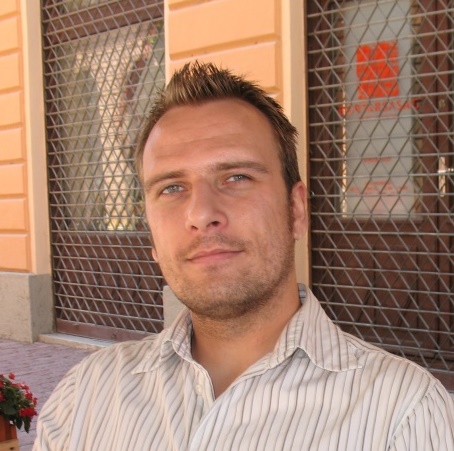 Róbert Huszánk was born in 1979 in Debrecen, Hungary. He
studied chemistry at the Department of General and Inorganic Chemistry
of University of Pannonia (Veszprém, Hungary) and obtained his
M.Sc. in chemistry in 2002. He started his Ph.D. studies in inorganic
photochemistry in 2003 at the Department of General and Inorganic
Chemistry of University of Pannonia, Veszprém, Hungary. His
Ph.D. work focused on the preparation of water-soluble, heme-like
iron(II) and iron(III) porphyrin complexes and the investigation of
their formation kinetics, photochemistry and photophysics. He defended
his Ph.D. thesis in 2007. After the end of dissertation research
(Ph.D. studentship), in September 2006, he started a new research
topic in the Laboratory of Ion Beam Applications at the Institute of
Nuclear Research of the Hungarian Academy of Sciences, Debrecen,
Hungary. Since then, his research activities are focusing mainly on
the application of ion beam for different purposes like analysis (RBS,
ERDA), polymer surfaces modification and investigation of the chemical
and physical changes, moreover, application of micromachining
technique to create microreactors, micro-fluidic and micro-optical
devices. He has been a member of the organizing committees of two
international conferences. He has published 10 papers in refereed
journals.
[top] [personal webpage]
Róbert Huszánk was born in 1979 in Debrecen, Hungary. He
studied chemistry at the Department of General and Inorganic Chemistry
of University of Pannonia (Veszprém, Hungary) and obtained his
M.Sc. in chemistry in 2002. He started his Ph.D. studies in inorganic
photochemistry in 2003 at the Department of General and Inorganic
Chemistry of University of Pannonia, Veszprém, Hungary. His
Ph.D. work focused on the preparation of water-soluble, heme-like
iron(II) and iron(III) porphyrin complexes and the investigation of
their formation kinetics, photochemistry and photophysics. He defended
his Ph.D. thesis in 2007. After the end of dissertation research
(Ph.D. studentship), in September 2006, he started a new research
topic in the Laboratory of Ion Beam Applications at the Institute of
Nuclear Research of the Hungarian Academy of Sciences, Debrecen,
Hungary. Since then, his research activities are focusing mainly on
the application of ion beam for different purposes like analysis (RBS,
ERDA), polymer surfaces modification and investigation of the chemical
and physical changes, moreover, application of micromachining
technique to create microreactors, micro-fluidic and micro-optical
devices. He has been a member of the organizing committees of two
international conferences. He has published 10 papers in refereed
journals.
[top] [personal webpage]
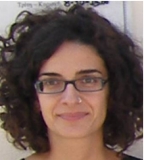 Vicky Kantarelou was born in 1971 in Athens, Greece. She studied
physics at the University of Patras and graduated in 1995. In 2003 she
was awarded with a full doctoral scholarship from the Institute of
Nuclear Physics of NCSR "Demokritos” after written
examinations. In 2005 she completed a master course in Physics at the
Department of Applied Mathematics and Physics at the National
Technical University of Athens (NTUA). Since then she is working for
her PhD thesis entitled “Development, evaluation and application of
a micro-X ray fluorescence spectrometer on cultural heritage”. She
has 6 publications in conference proceedings.
[top] [personal webpage]
Vicky Kantarelou was born in 1971 in Athens, Greece. She studied
physics at the University of Patras and graduated in 1995. In 2003 she
was awarded with a full doctoral scholarship from the Institute of
Nuclear Physics of NCSR "Demokritos” after written
examinations. In 2005 she completed a master course in Physics at the
Department of Applied Mathematics and Physics at the National
Technical University of Athens (NTUA). Since then she is working for
her PhD thesis entitled “Development, evaluation and application of
a micro-X ray fluorescence spectrometer on cultural heritage”. She
has 6 publications in conference proceedings.
[top] [personal webpage]
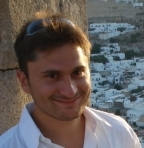 Theodore Konstantinopoulos was born in Athens in 1982. He studied
physics at the Physics Department of the National Technical University
of Athens (NTUA) and graduated in 2006. In the same year he succeeded
in his PhD qualifying examinations of NTUA and was granted a four year
scholarship from the Institute of Nuclear Physics of NCSR
"Demokritos" to elaborate his PhD. He is currently working
on his master thesis concerning measurements of α-capture reaction
cross sections relevant to Nuclear Astrophysics and also on his PhD
thesis which focuses on lifetime measurements of excited nuclear
states using the Coulex-Plunger method in inverse kinematics.
[top] [personal webpage]
Theodore Konstantinopoulos was born in Athens in 1982. He studied
physics at the Physics Department of the National Technical University
of Athens (NTUA) and graduated in 2006. In the same year he succeeded
in his PhD qualifying examinations of NTUA and was granted a four year
scholarship from the Institute of Nuclear Physics of NCSR
"Demokritos" to elaborate his PhD. He is currently working
on his master thesis concerning measurements of α-capture reaction
cross sections relevant to Nuclear Astrophysics and also on his PhD
thesis which focuses on lifetime measurements of excited nuclear
states using the Coulex-Plunger method in inverse kinematics.
[top] [personal webpage]
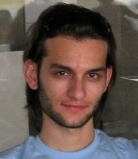 Dimosthenes Sokaras, born in October 1982, completed his undergraduate
studies at the Physics Department of the National Technical University
of Athens (NTUA) in 2005. Right after his graduation, he was granted a
scholarship after examination from the Institute of Nuclear Physics
(INP) of NCSR "Demokritos". In 2007, he received his MSc degree from
NTUA. As a PhD scholar of INP he is currently working for his PhD
thesis entitled "Development of new techniques for elemental analysis
using proton-induced X-rays". His scientific interests focus on the
research and development of ion-beam and X-ray based analytical
techniques. He has participated in various R&D activities of the group
such as the implementation and development of the Confocal micro-PIXE
technique (3D-PIXE), the realization of an external ion-beam station
at the Tandem accelerator of INP, the design, installation and operation of a novel
PIXE-XRF chamber. He has, furthermore participated in a series of
collaboration experiments abroad in several European laboratories
including BESSY II in Berlin, Germany, the Jozef Stefan Institute in
Ljubljana, Slovenia, and AGLAE in Paris, France. At the same time he
participated in numerous international scientific meetings
(conferences, workshops and schools) and presented results from his
research activities.
[top] [personal webpage]
Dimosthenes Sokaras, born in October 1982, completed his undergraduate
studies at the Physics Department of the National Technical University
of Athens (NTUA) in 2005. Right after his graduation, he was granted a
scholarship after examination from the Institute of Nuclear Physics
(INP) of NCSR "Demokritos". In 2007, he received his MSc degree from
NTUA. As a PhD scholar of INP he is currently working for his PhD
thesis entitled "Development of new techniques for elemental analysis
using proton-induced X-rays". His scientific interests focus on the
research and development of ion-beam and X-ray based analytical
techniques. He has participated in various R&D activities of the group
such as the implementation and development of the Confocal micro-PIXE
technique (3D-PIXE), the realization of an external ion-beam station
at the Tandem accelerator of INP, the design, installation and operation of a novel
PIXE-XRF chamber. He has, furthermore participated in a series of
collaboration experiments abroad in several European laboratories
including BESSY II in Berlin, Germany, the Jozef Stefan Institute in
Ljubljana, Slovenia, and AGLAE in Paris, France. At the same time he
participated in numerous international scientific meetings
(conferences, workshops and schools) and presented results from his
research activities.
[top] [personal webpage]
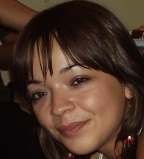 Born in 1982, Varvara Foteinou studied physics at the National
Technical University of Athens (NTUA). In 2007 she was granted a
scholarship after examinations from the Institute of Nuclear Physics
of NCSR "Demokritos" for post-graduate studies leading to a
PhD. In 2008, she successfully passed the PhD qualifying examinations
of NTUA. She is currently working for her MSc thesis to be defended
during spring 2009, before start working for her PhD that will focus
on charged-particle induced capture reactions relevant to stellar
nucleosynthesis. She has 4 publications in peer-reviewed journals.
[top] [personal webpage]
Born in 1982, Varvara Foteinou studied physics at the National
Technical University of Athens (NTUA). In 2007 she was granted a
scholarship after examinations from the Institute of Nuclear Physics
of NCSR "Demokritos" for post-graduate studies leading to a
PhD. In 2008, she successfully passed the PhD qualifying examinations
of NTUA. She is currently working for her MSc thesis to be defended
during spring 2009, before start working for her PhD that will focus
on charged-particle induced capture reactions relevant to stellar
nucleosynthesis. She has 4 publications in peer-reviewed journals.
[top] [personal webpage]
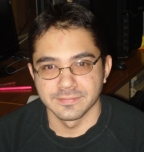 George Provatas was born in Corfu, Greece, in 1981. He studied physics
at the Physics Department of the National Technical University of
Athens (NTUA) and graduated in 2008. For his Diploma thesis entitled
"NRA differential cross-section measurements of
32S(d,p)33S for material analysis", he
carried measurements at the Tandem Accelerator of INP, NCSR
"Demokritos". In 2008 he was granted a four-year scholarship
from INP after written examinations to work for his PhD that will
focus on neutron-induced reactions of relevance to Nuclear
Astrophysics. In the same year he succeeded in his PhD qualifying
examinations of NTUA. He is currently working for his Master thesis.
[top] [personal webpage]
George Provatas was born in Corfu, Greece, in 1981. He studied physics
at the Physics Department of the National Technical University of
Athens (NTUA) and graduated in 2008. For his Diploma thesis entitled
"NRA differential cross-section measurements of
32S(d,p)33S for material analysis", he
carried measurements at the Tandem Accelerator of INP, NCSR
"Demokritos". In 2008 he was granted a four-year scholarship
from INP after written examinations to work for his PhD that will
focus on neutron-induced reactions of relevance to Nuclear
Astrophysics. In the same year he succeeded in his PhD qualifying
examinations of NTUA. He is currently working for his Master thesis.
[top] [personal webpage]
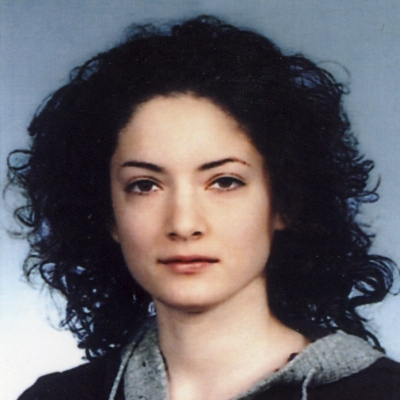 Valentina Paneta was born in Athens in 1986.
She studied physics at the Physics Department
of the National Technical University of Athens (NTUA).
She graduated in 2009, after presenting her
Diploma thesis entitled "Simulation of the neutron facility
at the NCSR Demokritos" with the use of the MCNP code.
In October 2009 she was granted a scholarship after examinations
from the Institute of Nuclear Physics (INP) of NCSR "Demokritos"
for her postgraduate studies leading to a PhD. She is currently
attending the required courses for her M.Sc degree.
[top] [personal webpage]
Valentina Paneta was born in Athens in 1986.
She studied physics at the Physics Department
of the National Technical University of Athens (NTUA).
She graduated in 2009, after presenting her
Diploma thesis entitled "Simulation of the neutron facility
at the NCSR Demokritos" with the use of the MCNP code.
In October 2009 she was granted a scholarship after examinations
from the Institute of Nuclear Physics (INP) of NCSR "Demokritos"
for her postgraduate studies leading to a PhD. She is currently
attending the required courses for her M.Sc degree.
[top] [personal webpage]
